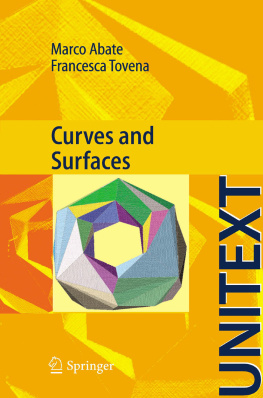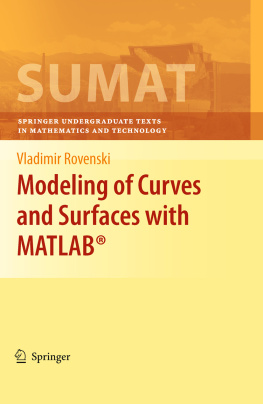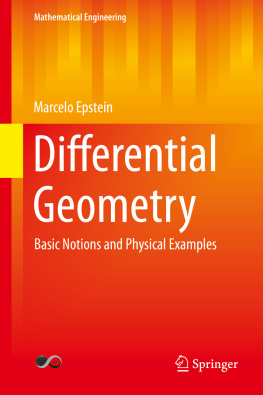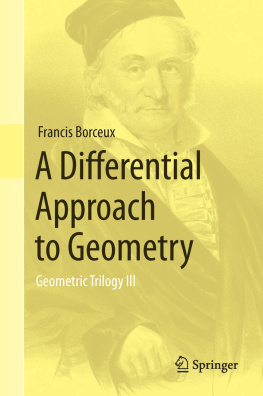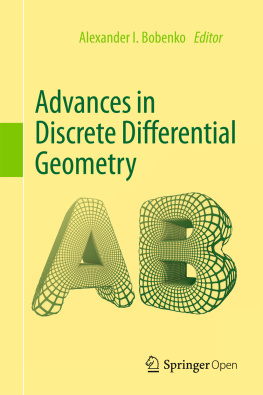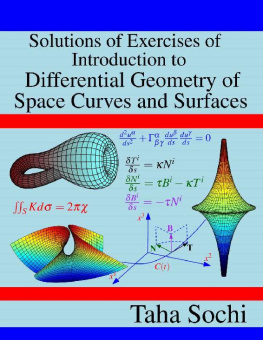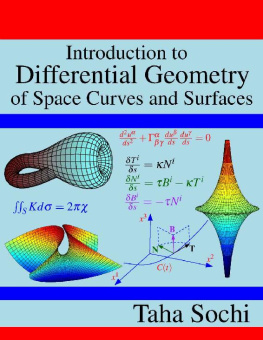Preface
The present book is about differential geometry of space curves and surfaces. The formulation and presentation are largely based on a tensor calculus approach, which is the dominant trend in the modern mathematical literature of this subject, rather than the geometric approach which is usually found in some old style books. The book is prepared, to some extent, as part of tutorials about topics and applications related to tensor calculus. It can therefore be used as part of a course on tensor calculus as well as a textbook or a reference for an intermediate-level course on differential geometry of curves and surfaces.
Apart from general background knowledge in a number of mathematical branches such as calculus, geometry and algebra, an important requirement for the reader and user of this book is familiarity with the terminology, notation and concepts of tensor calculus at reasonable level since many of the notations and concepts of differential geometry in its modern style are based on tensor calculus.
The book contains a mathematical background section in the first chapter to outline some important pre-required mathematical issues. However, this section is restricted to materials related directly to the contents of differential geometry of the book and hence the reader and user should not expect this mathematical background section to be comprehensive in any way. General mathematical knowledge, plus possible consultation of mathematical textbooks related to other disciplines of mathematics when needed, should therefore be considered.
The book is furnished with an index in the end of the book as well as sets of exercises in the end of each chapter to provide useful revisions and practice. To facilitate linking related concepts and parts, and hence ensure better understanding of the provided materials, cross referencing is used extensively throughout the book where these referrals are hyperlinked in the electronic version of the book for the convenience of the ebook users. The book also contains a considerable number of graphic illustrations to help the readers and users to visualize the ideas and understand the abstract concepts.
The materials of differential geometry are strongly interlinked and hence any text about the subject, like the present one, will face the problem of arranging the materials in a natural order to ensure gradual development of concepts. In this book we largely followed such a scheme. However, this is not always possible and hence in some cases references are provided to materials in later parts of the book for concepts needed in earlier parts. Nevertheless, in most cases brief definitions of the main concepts are provided in the first chapter in anticipation of more detailed definitions and investigations in the subsequent chapters.
Regarding the preparation of the book, everything is made by the author including all the graphic illustrations, indexing, typesetting, book cover, as well as overall design. In this regard, I should acknowledge the use of LaTeX typesetting package and the LaTeX based document preparation package LyX which facilitated the typesetting and design of the book substantially.
Taha Sochi
London, March 2017
Table of Contents
Nomenclature
In the following table, we define some of the common symbols, notations and abbreviations which are used in the book to provide easy access to the reader.
| nabla differential operator |
| Laplacian operator |
| ~ | isometric to |
| , subscript | partial derivative with respect to the following index(es) |
| ; subscript | covariant derivative with respect to the following index(es) |
| 1D, 2D, 3D, n D | one-, two-, three-, n -dimensional |
| overdot (e.g. r ) | derivative with respect to general parameter t |
| prime (e.g. r ) | derivative with respect to natural parameter s |
| t | absolute derivative with respect to t |
| , i | partial derivative with respect to th and i th variables |
| a | determinant of surface covariant metric tensor |
| a | surface covariant metric tensor |
| a 11 ,a 12 ,a 22 | coefficients of surface covariant metric tensor |
| a 11 ,a 12 ,a 22 | coefficients of surface contravariant metric tensor |
| a , a , a | surface metric tensor or its components |
| b | determinant of surface covariant curvature tensor |
| b | surface covariant curvature tensor |
| B | binormal unit vector of space curve |
| b 11 ,b 12 ,b 22 | coefficients of surface covariant curvature tensor |
| b , b , b | surface curvature tensor or its components |
| C | curve |
| C B , C N , C T | spherical indicatrices of curve C |
| C e , C i | evolute and involute curves |
| C n | of class n |
| c , c , c | tensor of third fundamental form or its components |
| d | Darboux vector |
| d 1 , d 2 | unit vectors in Darboux frame |
| det | determinant of matrix |
| ds | length of infinitesimal element of curve |
| ds B ,ds N ,ds T | length of line element in binormal, normal, tangent directions |
| d | area of infinitesimal element of surface |
| e ,f ,g | coefficients of second fundamental form |
| E ,F ,G | coefficients of first fundamental form |
| , , V | number of edges, faces and vertices of polyhedron |
| E i , E j | covariant and contravariant space basis vectors |
| E , E | covariant and contravariant surface basis vectors |
| Eq./Eqs. | Equation/Equations |
| f | function |
| Fig./Figs. | Figure/Figures |
| g | topological genus of closed surface |
| g ij , g ij | space metric tensor or its components |
| H | mean curvature |
| I S , II S , III S | first, second and third fundamental forms |
| I S , II S | tensors of first and second fundamental forms |
| iff | if and only if |
| J | Jacobian of transformation between two coordinate systems |
| J | Jacobian matrix |
| K | Gaussian curvature |
| K t | total curvature |
| L | length of curve |
| n | normal unit vector to surface |
| N | principal normal unit vector to curve |
| P | point |
| r , R | radius |
| Ricci curvature scalar |
| r | position vector |
| r , r | 1st and 2nd partial derivative of r with subscripted variables |
| R 1 , R 2 | principal radii of curvature |
| n | n -dimensional space (usually Euclidean) |
| R ij , R ij | |



